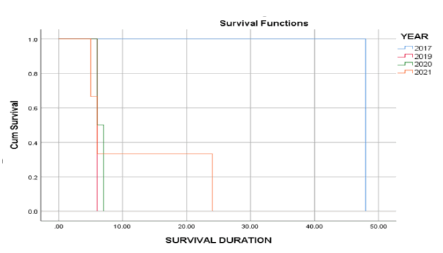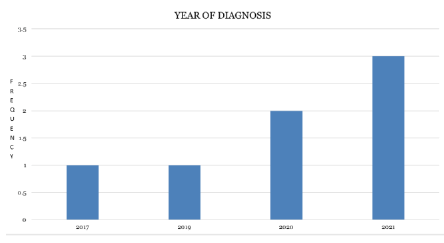Research Article - Onkologia i Radioterapia ( 2023) Volume 17, Issue 5
Demographic and overall survival pattern of diffuse large b-cell lymphoma in the university of Calabar teaching hospital, Calabar
Kingsley Akaba1*, Edak Akaba2 and Eyam S Eyam32Department of Histopathology, University of Calabar Teaching Hospital, Nigeria
3Department of Chemical Pathology, University of Calabar Teaching Hospital, Nigeria
Kingsley Akaba, Department of Hematology and Blood Transfusion University of Calabar Teaching Hospital, Nigeria, Email: akaba_kingsley@yahoo.com
Received: 10-Mar-2023, Manuscript No. OAR-22-91360; Accepted: 30-Apr-2023, Pre QC No. OAR-22-91360 (PQ); Editor assigned: 15-Mar-2023, Pre QC No. OAR-22-91360 (PQ); Reviewed: 30-Mar-2023, QC No. OAR-22-91360 (Q); Revised: 26-Apr-2023, Manuscript No. OAR-22-91360 (R); Published: 02-May-2023
Abstract
Background: In Diffuse Large B-cell Lymphoma is an aggressive heterogeneous form of Non-Hodgkin’s lymphoma. There is dreath of information in the demographics and overall survival in low resource setting. The aim of this study is to determine the demography and overall survival pattern of Adult DLBCL at the University of Calabar Teaching Hospital. Method: The study is a retrospective study of 7 DLBCL patients seen and managed at the UCTH from June 2017 to August 2021. Male/female distribution was 2.5/1, with a median age of 62 years. Overall Survival (OS) and Progression Free Survival (PFS) were determined using the Kaplan-Meier techniques. The data were analysed using Microsoft Excel 2016 and IBM SPSS version 21. Results: Total of 7 DLBCL patients were seen over the 5-year-period of review median age 62 years. There were 5 males and 2 females. This study also shows an overall survival of 48 months with a median survival of 6.5 months. The survival distributions were not statistically significantly different, X2=3.204, p=0.073. Conclusion: There is inconsistency in the demographic and overall survival pattern of Diffuse large B Cell lymphoma in our environment. Further study is needed to identify the factors which can help to improve the overall survival pattern in our environment.
Keywords
B-cell lymphoma, overall survival, survival rate.
Introduction
Pain is an emotional and psychological mood, Diffuse Large B-Cell Lymphoma (DLBCL) constitutes 30%-40% of all cases of Non-Hodgkin Lymphoma worldwide [1]. DLBCL is the most common subtype of Non-Hodgkin lymphoma [2]. DLBCL is heterogeneous group of lymphoma with significant variation in clinical biological characteristics, response treatment and outcome. DLBCL is an aggressive lymphoma with poor prognosis [3]. Previously CHOP has been the mainstream of treatment with survival rate below 50% [4]. Thus the trend has changed with the addition of monoclonal antibody Rituximab (R-CHOP) and the survival rate has improved. DLBCL is said to occur more in male and older age of fifty and above [5]. There is dreath of information on the demographic and survival pattern of DLBCL in our environment. The aim of this study is to determine the demographic and overall survival pattern of DLBCL at the University of Calabar Teaching Hospital.
Material and Method
Age
59 years-75 years.
Study Design
This study was a retrospective study of diffuse large B-cell Lymphoma seen at the UCTH from 2017-2021.
Study Area
The University of Calabar Teaching Hospital is a 600 bed Tertiary Health Institution that renders specialist care to its host and neighbouring communities
Subject
This include 7 patients diagnosed with DLBCL at our facilities via histology and confirmed with immunohistochemistry and have or yet to commence chemotherapy at the haematology Day Care Unit
Selection Criteria
Those whose information was retrieved from the cancer registry and hospital record, also patient’s folder were included in the study while those with omission and discrepancies from any part of the archives were excluded from the study. Furthermore, those who cannot be traced were also excluded. These data results collated were analysed using Microsoft Excel 2016 and IBM SPSS version 21. The data were analysed using simple inferential statistics (frequency and percentage). Survival analysis was done using Kaplan-Meier method for the survival studies. Overall Survival (OS) was calculated as: the number of subjects surviving divided by the number of subjects at risk (Table 1 and Figure 1 and 2).
Tab. 1. Showing the demographics of the patients
| Demographics | Frequency | Percentage (%) | |
|---|---|---|---|
| Sex | Male | 5 | 71.43 |
| Female | 2 | 28.57 | |
| Status | Dead | 6 | 85.71 |
| Alive | 1 | 14.29 | |
| Duration of survival (Months) | 5 | 1 | 14.29 |
| 6 | 3 | 42.86 | |
| 7 | 1 | 14.29 | |
| 24 | 1 | 14.29 | |
| 28 | 1 | 14.29 | |
Figure 1:Years of diagnosis

Figure 2: Kaplan-Meier survival graph: A log rank test was run to determine if there were differences in the survival distribution for the different period of diagnosis. The survival distributions for patients were not statistically significantly different, x2(2) = 2.732, p=0.435
Result and Discussion
This study shows inconsistency with available data on the demography and overall survival of diffuse B-cell lymphoma. Diffuse large B-cell lymphoma constitutes 4.9% and 36.4% of all adult lymphoma and haematological malignancies respectively during the period of review. This is similar to the finding by Madu et al., Hedstrom et al. also reported similar finding [6,4]. This study also reported male preponderance with a male to female ratio 2.5:1. This is similar to the study by Madu et al. [6]. This difference can be attributed to occupational exposure. The median age of DLBCL in our study is 62 years. This is similar to the study by National Cancer Institute but differ from the study by Madu et al, this difference can be alluded to differences in study design as Madu et al. study was looking at heterogeneous group of NonHodgkin lymphoma [7,6]. Furthermore, this is also similar to the finding of a study conducted by a Swedish Lymphoma group in Sweden [4]. The overall survival pattern during the period of review showed an improvement from 2020 to 2021. This can be attributed to increased number of competent personnel, improved diagnosis and also affordability of Rituximab (Mabthera) due to the implementation of Cancer Associated Programme (CAP) knowing how the cost impeded the ability of patients to purchase the drug, but with the advent of CAP, it is now coming at a more discounted and affordable rate if more can be done to further reduce the cost and allow for more purchasing power. This study also shows an overall survival of 48 months with a median survival of 6.5 months. this is different from the study in the western world which reveal 5 years [8]. which can be attributed to late presentation due to Spiritism, delay in diagnosis, inadequate personnel, increased prevalence of co morbidity such as (HIV, Diabetes Mellitus) and low social economic status.
The limitations of this study include those inherent to any retrospective study, while DLBCL diagnosis is documented.
References
- Jemal A, Siegel R, Ward E, Hao Y, Xu J, et al. Cancer statistics, 2009. CA: Cancer J Clin. 2009; 59:225-249.
- Morton LM, Wang SS, Devesa SS, Hartge P, Weisenburger DD, et al. Lymphoma incidence patterns by WHO subtype in the United States. 1992-2001. Blood. 2006; 107:265-276.
- Fisher RI, Gaynor ER, Dahlberg S, Oken MM, Grogan TM, et al. Comparison of a standard regimen (CHOP) with three intensive chemotherapy regimens for advanced non-Hodgkin's lymphoma. N Engl J Med. 1993; 328:1002-1006.
- Hedstrom G, Hagberg O, Jerkeman M, Enblad G, Swedish Lymphoma Study Group. The impact of age on survival of diffuse large B-cell lymphoma–a population-based study. Acta Oncol. 2015; 54:916-923.
- Coiffier B, Lepage E, Briere J, Herbrecht R, Tilly H, et al. CHOP chemotherapy plus rituximab compared with CHOP alone in elderly patients with diffuse large-B-cell lymphoma. N Engl J Med. 2002;346:235-242.
[Google Scholar] [CrossRef]
- Madu AJ, Korubo K, Ajuba IC, Ugwu NI, Okoye AE, et al. Non-hodgkin lymphoma in Nigeria: An insight into the clinical, laboratory features and outcomes. Asian Hematol Res J. 2020; 3:13-22.
- All Cancer Sites Combined. Recent Trends in SEER Age-Adjusted Incidence Rates, 2000-2019. SEER database. 2017.
- Hamlin PA, Satram-Hoang S, Reyes C, Hoang KQ, Guduru SR, et al. Treatment patterns and comparative effectiveness in elderly diffuse large B-cell lymphoma patients: a surveillance, epidemiology, and end results-medicare analysis. Oncologist. 2014; 19:1249-1257.




